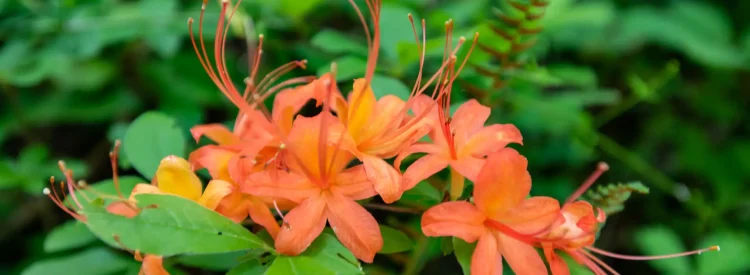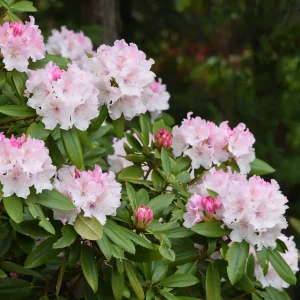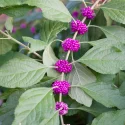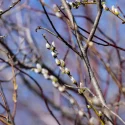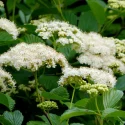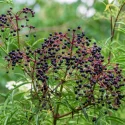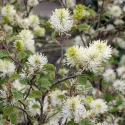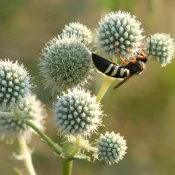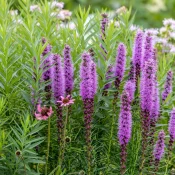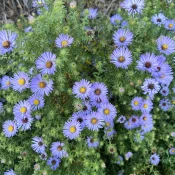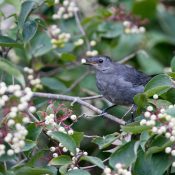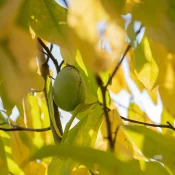Native azaleas are extraordinary sights when they bloom, in part because they have minimal leaves when flowering. Seventeen species of azalea are native to North America, each with flowers that range from white, pink, yellow, or orange. They are not just for the spring: their leaves turn fiery colors in the fall before dropping off. If you live anywhere in the eastern US from New Hampshire to Florida, or on the West Coast in California or Oregon, you can happily plant these beautiful shrubs. Scroll on to meet some favorites.
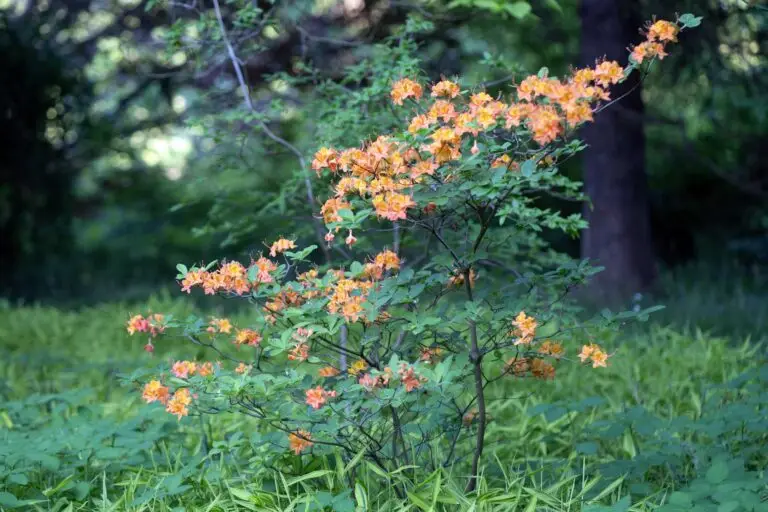
Azaleas are found worldwide, with over a dozen native options available for North American gardens. No matter the species, all azaleas cover themselves in five-petaled flowers in the spring. This shrub (or bush? whatever your naming preference) is a pollinator’s dream. In this article, we will cover the differences between non-native and native azaleas, introduce a few native options (with pictures), and share tips for planting.
Let’s get started with a basic question.
What is the difference between native vs. non-native azaleas?
There are thousands of azaleas worldwide, most of which come from Asia. Seventeen azalea species are native to North America. (This number comes from the Azalea Society of America; we’ve seen it range from 14 to 18 depending on the source.)
Here are the general differences between non-native and native azaleas:
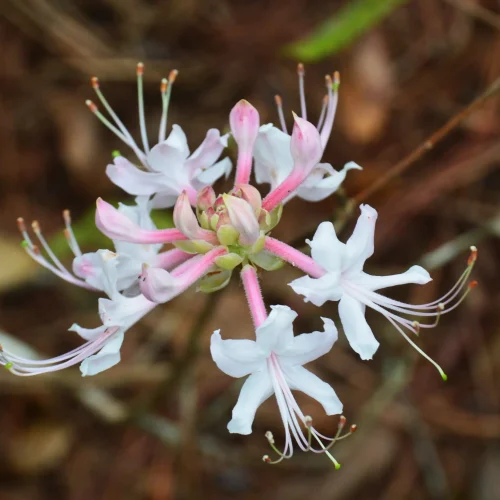
Native Azaleas
- Lose leaves in winter (deciduous)
- Five petals, long, eyelash-y stamens
- Flowers often smell fantastic!
- More airy, open shape
- Require minimal care: happy with rain when established, thrive in Southern climates
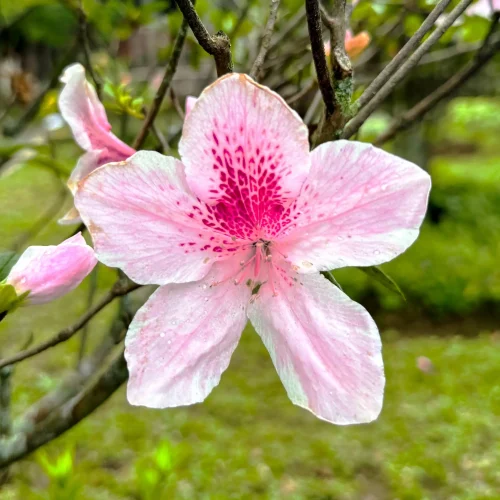
Non-Native Azaleas
- Most are evergreen
- Five petals, short stamens
- Most flowers have no smell
- Dense, mounded shape
- Can require special care: fertilizing, pruning, watching out for root rot and other diseases
And now you’re probably wondering if the azaleas in your yard or nearby are native—right?
Sad news: most azaleas in American landscapes are non-native
This bummed us out when we realized it.
Drive around along the Mid-Atlantic or South in the spring, and you’ll see a riot of azalea shrubs in bloom. Sadly—very few of the azaleas in American landscapes are native species.
American landscaping trends have favored evergreen, non-native azaleas since the 1800s, which is why the bulk of azaleas in our landscapes are non-native.
The vast majority of azaleas planted in southern parks and gardens are non-native Asian species.
Even iconic southern azalea gardens are mostly non-native
If you’ve been to any well-known azalea gardens or festivals in the south—Summerville, South Carolina’s Azalea Park, Flowerfest, and the Magnolia Plantation—we have some sad news. The vast majority of azaleas planted in southern parks and gardens are non-native Asian species.
And now you may be asking…
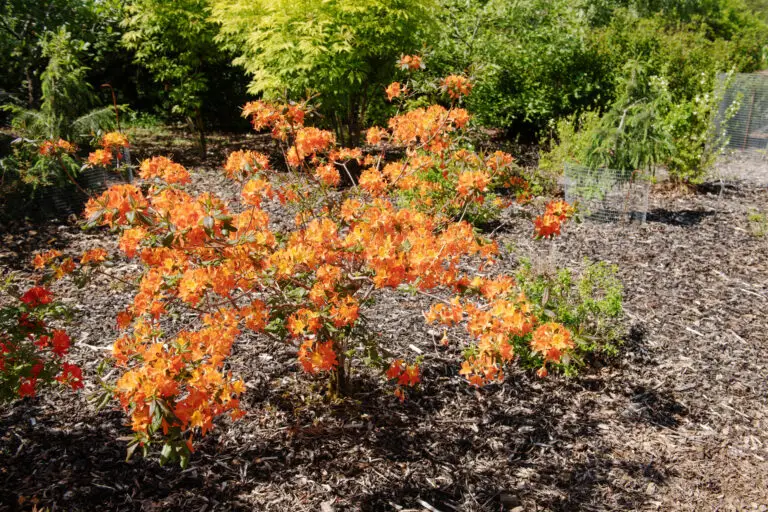
What are the benefits of planting a native azalea?
Besides all the reasons mentioned earlier—fragrant flowers and iconic blooms—there are many reasons to plant native azaleas and native plants. Here are three benefits of planting native azaleas:
- Support wildlife: without native plants, iconic animals like Monarch butterflies and songbirds won’t have the food or homes needed to survive.
- Native plants save time and money. After the first year of establishment, they are happy with rain.
- Fuss-free beauty: Native plants are gorgeous! Azaleas are a perfect example of how beautiful and resilient native plants are—they are always the best choice for our gardens.
- Fall foliage: Many native azalea leaves turn into warm shades of yellow-bronze before falling.
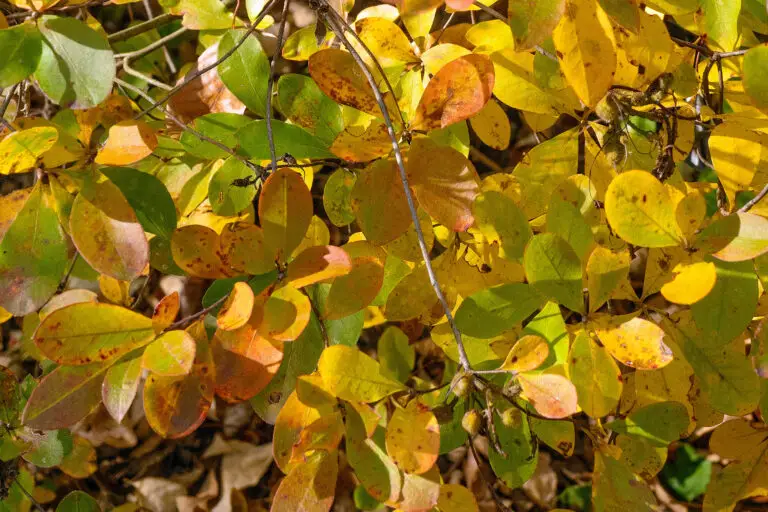
We’ve heard the benefits. Now, let’s see some pictures and meet the native options.
Meet the North American Native Azaleas
Native azalea flowers run from white to pink to yellow.
Organized roughly into regions.
Azaleas for the Northeast, Mid-Atlantic, and South
These azaleas have wide native ranges; sometimes from New York down to the South.
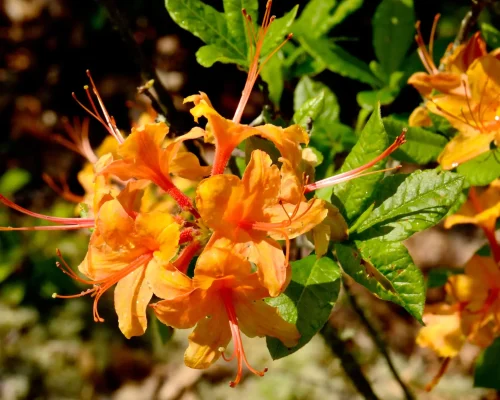
Flame Azalea
Rhododendron calendulaceum
The name tells you the color before you ever see it. Warm glowing flowers come in the spring. Native Flame Azaleas can come in a range of warm colors, making them known as “one of the most spectacular native shrubs of the Appalachian Mountains.” Flame Azaleas grow to 6-12 feet tall and like part shade to shade. Native from New York south to Alabama.
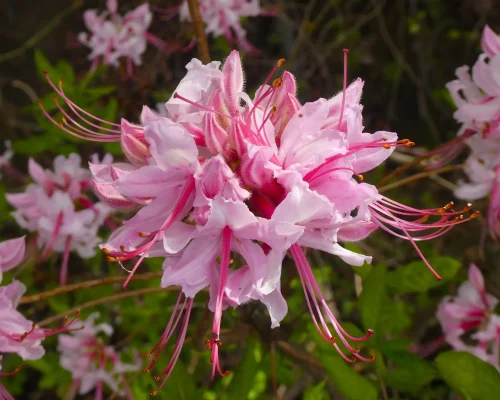
Pinxterbloom Azalea
Rhododendron periclymenoides
What a beautiful pink azalea! Light pink petals frame dark pink stamens, a dramatic combination. It is native from New Hampshire to Alabama. Shade to part shade work best. Uri Lorimer, who heads the Native Plant Trust, recommends Pinxterblooms for New England gardens.
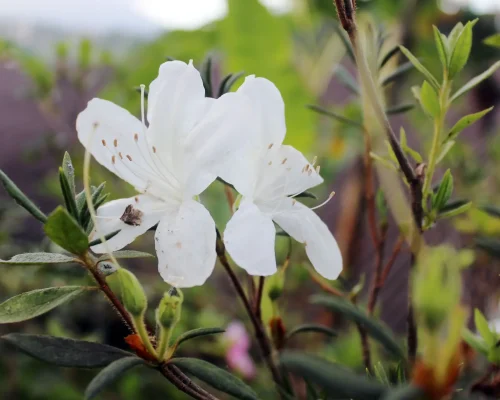
Swamp Azalea
Rhododendron viscosum
Swamp Azaleas—what a terrible name for a beautiful plant. Similar to Alabama Azaleas, Swamp Azaleas have beautiful white flowers. They have a huge native range: look for them on stream banks from Maine to Georgia and west to Texas.
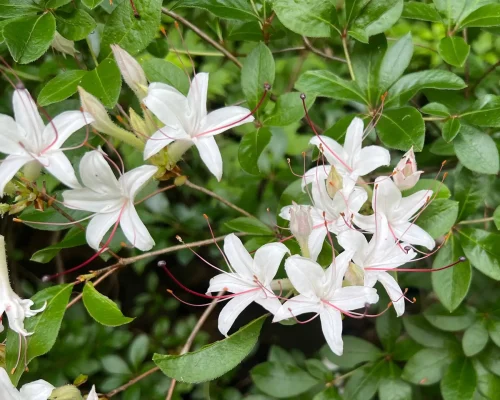
Sweet or Smooth Azalea
Rhododendron Arborescens
Sweet Azaleas (also sometimes called Smooth Azaleas) have delicate white to pale yellow flowers and long red stamens, which look almost like eyelashes. They also smell amazing. Leaves turn a bright reddish-orange before they drop in the fall. Sweet Azaleas like part shade to shade and grow up to 9-20 feet tall. Native from New York to Mississippi.
Azaleas for the South
These azaleas don’t mind the heat and weather of the southern United States.
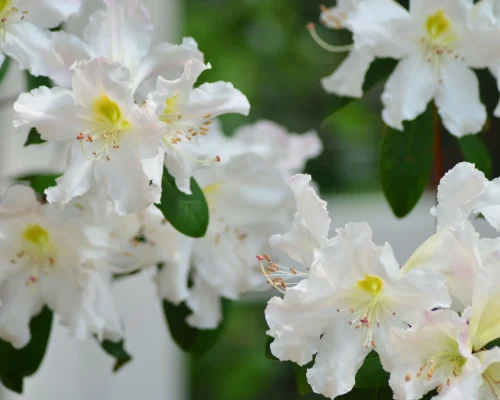
Alabama Azalea
Rhododendron alabamense
Alabama Azaleas offer a classic white flower with delicate yellow radiating from its center. The flowers also have a lovely lemony fragrance. It is perhaps the most black-tie of the native Azalea bunch. Native to a smaller, all-Southern range: Tennessee to Florida.
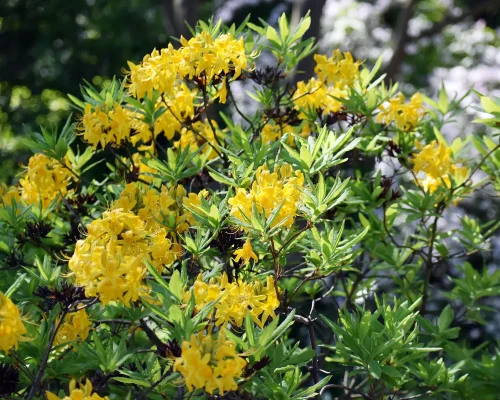
Florida Flame Azalea
Rhododendron austrinum
A little more buttery than its ‘flame’ cousin, the Florida Flame Azalea is usually easy to find in native nurseries, particularly in the south. Florida Flame blossoms also have a sweet smell, which no doubt helps make them a favorite of pollinators and homeowners. It flowers a little later than Piedmonts. Plant a few Piedmonts next to Florida Flames for a truly spectacular spring. Florida Flame Azaleas grow to 5-12 feet tall and like a wide range of light: sun to shade. Native to the the hot, humid south: from Florida to Mississippi.
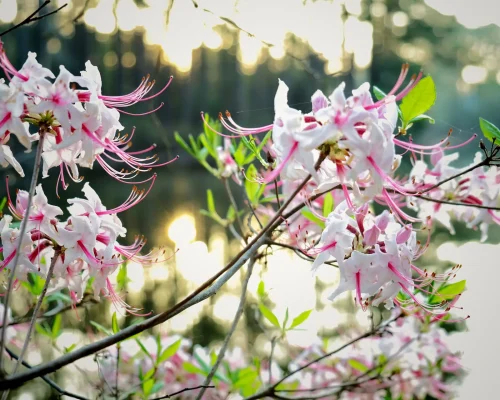
Piedmont or Mountain Azalea
Rhododendron canescens
Piedmont Azaleas (also called Mountain Azaleas) are the most common native azalea in the South. They can handle hot southern summers and even sunny garden placement. They grow natively from Tennessee south to central Florida and west to Texas. In the South, they flower in March (sometimes flowers come before the leaves). In northern climates, expect flowers in May.
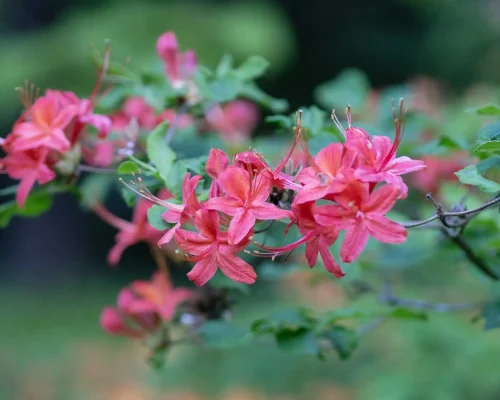
Plumleaf Azalea
Rhododendron prunifolium
A warm orange, reddish hue helps these bushes look almost in flame from a distance. Native to just two states: Mississippi and Alabama, but happily grows outside its range. This is the latest blooming of the east coast azaleas, blooming from July through to August.
Azaleas for the West Coast
There is just one azalea native to the West Coast (California and Oregon, specifically.) But wow—what a stunner.
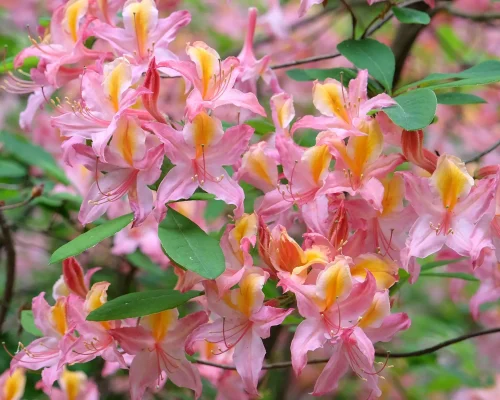
Western or Pacific Azalea
Rhododendron occidentale
Let’s end with the native azalea for those on the West Coast: Western Azaleas. And what a beauty! Pink flowers with radiant orange centers help attract pollinators (and Instagram pictures). Western Azaleas are native to California and Oregon.
When do these azaleas bloom?
It depends on the species. The table below is organized by bloom time:
| Common Name | Species | Bloom Time | Colors |
|---|---|---|---|
| Pinxterbloom Azalea | R. periclymenoides | April/May | Pink |
| Piedmont/Mountain Azalea | R. canescens | April/May | White |
| Coastal Azalea | R. atlanticum | May/June | White |
| Swamp Azalea | R. viscosum | May/June | White |
| Flame Azalea | R. calendulaceum | May/June | Yellow, Orange |
| Cumberland Azalea | R. bakeri | June | Red |
| Sweet Azalea | R. arborescens | June/July | White |
| Plumleaf Azalea | R. prunifolium | July/August | Red, Orange |
What about the other native azaleas?
Besides the azaleas we just met, other native azaleas are either native to smaller regions or difficult to find in nurseries. If you see these at a native nursery, plant sale, or elsewhere—scoop them up immediately! If you spot them in the wild or in a botanical garden, take many pictures (but leave them alone.)
Other native azaleas include:
- Coastal Azalea (Rhododendron atlanticum)
- Cumberland Azalea (Rhododendron cumberlandense)
- Oconee Azalea (Rhododendron flammeum)
- Pinkshell Azalea (Rhododendron vaseyi)
- Red Hills Azalea (Rhododendron colemanii)
- Rhododendron eastmanii — not available commercially; recently discovered (Rhododendron eastmanii)
- Roseshell Azalea (Rhododendron prinophyllum)
- Texas Azalea (Rhododendron oblongifolium)
- Rhodora (very rare, three-petaled, and once thought to be its own genus! Rhododendron canadense)
Congrats, you’ve met all seventeen of North America’s native azaleas! As we head into planting tips, you might have one more question—
Azaleas vs. Rhododendrons: What’s the difference?
Both azaleas and rhododendrons belong to the Rhododendron genus, so it’s easy to confuse them. Here’s the simplest way to tell them apart:
- Native azaleas: Lose their leaves in winter (deciduous).
- Native rhododendrons: Keep their leaves year-round (evergreen).
Now, let’s discuss how to grow native azaleas in your yard or park. These helpful tips apply no matter where you live or what species you plant.
How do you grow native azaleas?
We’ve assembled some stellar advice for planting, and before we dive in, we want to introduce an expert:
Meet the Johnny Appleseed of native azaleas
The largest supplier of native azaleas in the United States is Carolina Native Nursery, founded and led by Bill Jones. The nursery produces tens of thousands of native azaleas each year. His advice for planting is below, and visit our interview with Bill to find more native azalea tips.
Bill Jones’ Advice for Planting Native Azaleas
Native azaleas, like rhododendrons, mountain laurels, and other ericaceous plants, are shallow-rooting. And they do not like clay or heavy soils.
We recommend folks dig very shallow holes and leave the plant high and well-mulched. Planting deep is the kiss of death. Like all newly planted landscape plants, they need to be watched through the first year for dry times and water deeply as needed. Never daily.
Like Bill said—keep the H20 consistent
During the first year of planting an azalea, it’s essential to ensure the roots get consistent water. This will help the plant stay healthy and come back with blooms for years to come. This first year is like freshman year for plants. In gardening, it’s called “getting established.”
Other planting tips for native azaleas also depends on the season. Here’s what to keep in mind:
Planting azaleas in the fall
Fall is the ideal time to plant azaleas because they will spend all their energy on roots, and not on making flowers or leaves. Oftentimes, local nurseries offer sales in the fall to help clean out stock and prepare for spring. This is a great time to find native azaleas affordably and plant them during an ideal time for their growth and health. Azaleas planted in the fall will bloom in the spring.
Planting azaleas in the winter and spring
When you plant azaleas in the winter or spring, make sure to give them extra water during dry periods. The roots in particular need consistent water during the first year, especially for good flowering. A good rule of thumb is “moist but not soggy.” If you see water pooled around the azalea, hold back on watering.
Planting azaleas in the summer
It is even more crucial to give azaleas planted in the summer consistent water. If this will be a challenge for you (summer vacations are important!)—wait to plant until the fall. The first year planted, the roots will need watering whenever there is a dry or hot period. This will help them develop strong roots, even during summer heat. After the first year, azaleas should be fine with just rain.
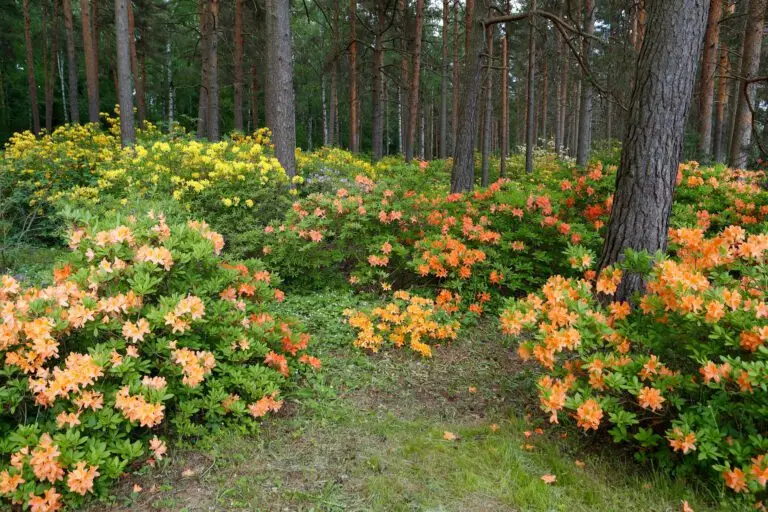
FAQs
Where should I plant native azaleas?
Azaleas are naturally found in forests beneath trees (the above picture is a perfect example.) They enjoy the sun in the spring and flower before the leaves grow and put them in persistent shade.
In our yards, they like a little bit of protection from the sun. They especially thrive:
- Up against houses or buildings
- As a hedgerow for driveways or property lines
- In front walkways, underneath statement trees (as seen above)
What happens if I plant an azalea in the wrong spot?
Don’t worry if you plant an azalea in the wrong spot; just move it to a better place. In deep shady areas, azaleas will become scraggly and not flower as much as when they are in dappled sun. Or, sometimes an azalea’s leaves will brown, showing it’s getting too much sun.
If either happens—don’t worry! It’s so easy to fix most gardening mistakes!
Just get out a shovel, make a wide hole around the root ball, and move the azalea to a better spot. Every gardener moves plants around. If you’re worried about making a planting mistake, read this pep talk on how to recover quickly.
Do azaleas need pruning?
There is no need to prune native azaleas unless you are looking for a more manicured shape. According to Gil Nelson’s Best Native Plants for Southern Gardens, “Allowing [azalea] plants to assume their natural form ensures more profuse flowering, a more charming habit, and a more naturalistic garden.”
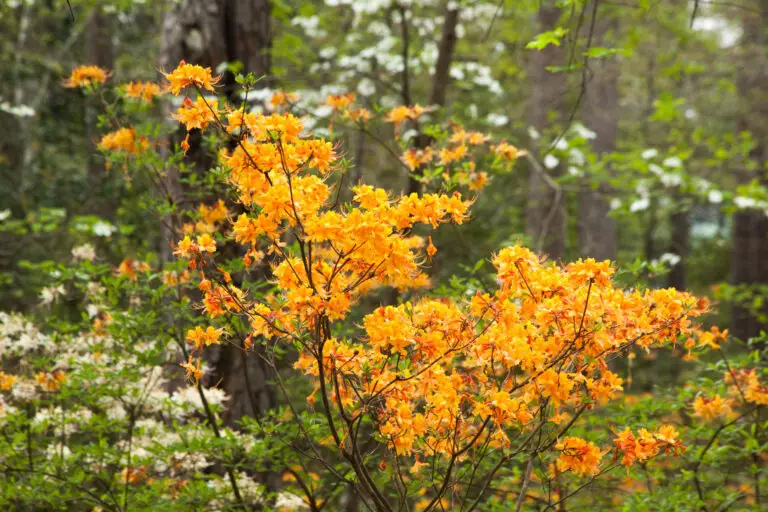
Where can I find native azaleas?
We won’t lie: sometimes, finding a specific native plant can be challenging, especially when visiting conventional nurseries. But you can find native azaleas if you know where to look! If you live within driving distance of Carolina Native Nursery in North Carolina, it’s worth a drive. As mentioned earlier, they are the largest supplier of native azaleas in the United States.
Otherwise, here are four ideas for sourcing native azaleas for your yard:
Where can I find seeds and plants?
Finding native plants can be challenging (we partly blame Marie Antoinette.) To make it easier, we’ve assembled four sourcing ideas.
300+ native nurseries make finding one a breeze
Explore 100+ native-friendly eCommerce sites
Every state and province has a native plant society; find yours
Online Communities
Local Facebook groups are a great plant source
What pairs well with native azaleas?
There are so many native plants that look great and pair nicely with native azaleas. Here are some stellar combinations for your garden.
Let’s all plant native azaleas
Native azaleas are a beautiful and easy-to-care-for addition to any garden. Their stunning flowers (that often smell amazing) are accompanied by leaves that turn vibrant colors in the fall. Native azaleas are perennials, meaning they will come back year after year looking better and better. Plant one (or a few!) native azaleas and enjoy years of blooms. Read our interview with azaleas’ Johnny Appleseed Bill Jones to hear more azalea info, or keep meeting some native icons in our Beginner’s Guide to Native Dogwoods or our Beginner’s Guide to Native Bee Balm. Happy planting!
Sources
- Lorimer, Uli. The Northeast Native Plant Primer. (2022), 96.
- Nelson, Gil. Best Native Plants for Southern Gardens: A Handbook for Gardeners, Homeowners, and Professionals. (2010).
- Rhodyman, Native Rhododendrons & Azaleas of North America
- Taylor, Patricia A. Easy Care Native Plants. (1996), 155-161.
- Azalea Chapter, ARS (2021). Southern Azalea and Rhododendron Species. https://www.azaleachapter.com/index.php/plant-info/plants/southern-azalea-and-rhododendron-species.
- Azalea Society of America, Deciduous Azaleas
- A NOTE: It was tough to settle on the number of azaleas native to North America. Southern Living’s Azaleas book says there are fourteen native species, while Rhodyman said eighteen. We decided the Azalea Society of America was the most recently updated, so we went with their number: seventeen.
Explore native plants by region
What if your feed was actually good for your mental health?
Give your algorithm a breath of fresh air and follow us.
